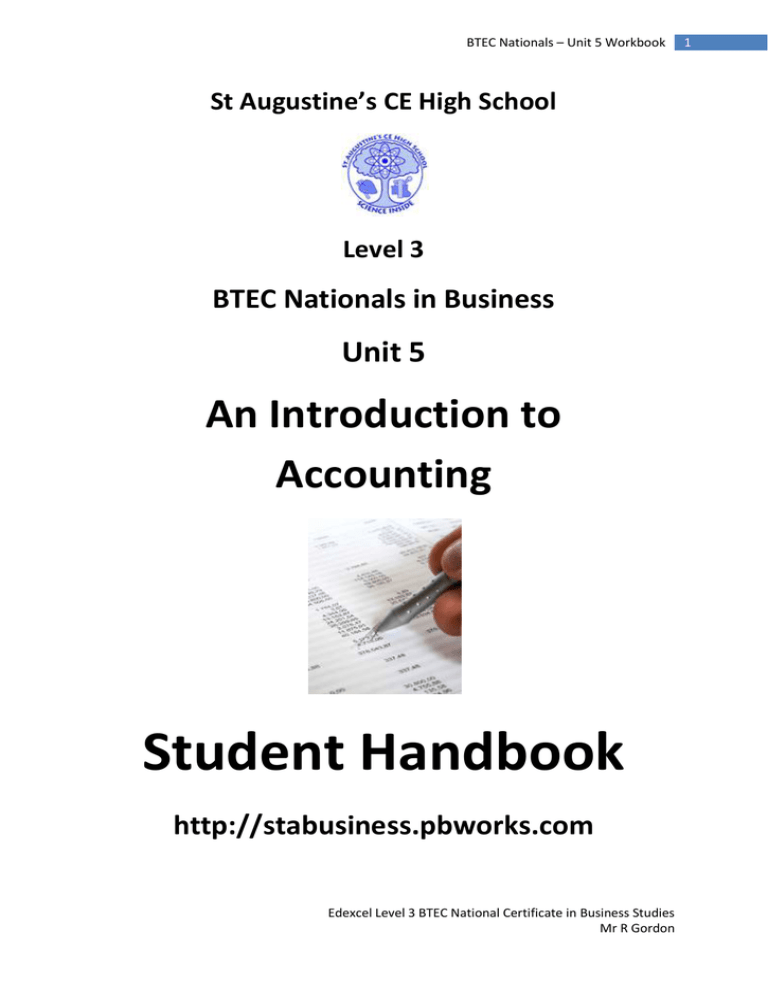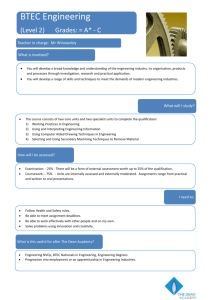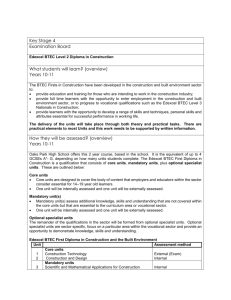Unit 5 Student book - stabusiness
advertisement

BTEC Nationals – Unit 5 Workbook St Augustine’s CE High School Level 3 BTEC Nationals in Business Unit 5 An Introduction to Accounting Student Handbook http://stabusiness.pbworks.com Edexcel Level 3 BTEC National Certificate in Business Studies Mr R Gordon 1 BTEC Nationals – Unit 5 Workbook Unit 5 – An Introduction to Accounting Understanding how a business operates and what makes it successful requires knowledge of the accounting process. This unit will introduce you to the purpose of accounting and its role in the management of a business organisation. Accounting involves the recording of business transactions, and this in turn, leads to the generation of financial information, which can be used as the basis of good financial control and planning. Inadequate record-keeping and a lack of effective planning ultimately lead to poor financial results. It is vital that owners and managers of businesses are able to recognise the indications of potential difficulties. Remedial action can then be taken. This unit should give learners the skills and knowledge needed to understand and manage finances. The unit is divided into two distinct parts. The first is an understanding of the accounting processes necessary to provide accurate and relevant financial information. The second part is the practical aspect of carrying out those accounting activities. You will be introduced to accounting terminology as you study the purpose and function of accounting and consider the various categories of business income and expenditure. It is important to know the sources of an organisation’s income and the nature of its expenditure as this clarifies the basis of its profitability and enables more effective control of the business. This control begins with the planning process and you will study the use of a cash flow forecast which requires managers to set cash flow targets that can be monitored and adjusted on a regular basis. You will consider the effective management of cash flow and the implications of cash flow problems. The link between business failures and cash flow problems will be highlighted. The measurement of an organisation’s financial performance and position requires an understanding of a basic profit and loss account and balance sheet. This understanding permits the analysis of profitability, liquidity and efficiency of the organisation through the application of ratio analysis. Analysis will always require comparison of current figures with those from a previous accounting period or those of a similar business organisation. You will discover the method of carrying out ratio analysis as well as the meaning and implication of the figures. Learning outcomes On completion of this unit you should be able to: Understand the purpose of accounting and the categorisation of business income and expenditure Be able to prepare a cash flow forecast Understand profit and loss accounts and balance sheets Be able to review business performance using simple ratio analysis. Edexcel Level 3 BTEC National Certificate in Business Studies Mr R Gordon 2 BTEC Nationals – Unit 5 Workbook Edexcel Level 3 BTEC National Certificate in Business Studies Mr R Gordon 3 BTEC Nationals – Unit 5 Workbook Task 1 – The Purpose of Accounting (P1) Please refer to the PowerPoint presentation entitled “An introduction to Finance & Accounts.ppt” at http://stabusiness.pbworks.com Task 1. Write a report titled “The Purpose of Accounting”. Your report should include the following information: A definition of the term "accounting" An explanation of the difference between "management" and "financial" accounting Three different examples of a financial accounting document. Provide print screens of any relevant examples you have found. An explanation of how each financial accounting document is used, and who uses it. An explanation of the implications of not completing financial accounts correctly Three different examples of a management accounting document. Provide print screens of any relevant examples you have found. An explanation of how each management accounting document is used, and who uses it. An explanation of the implications of not using management accounts correctly Research at least one news story which highlights the importance of a business keeping an accurate record of finances Task 2 – The Difference between capital and revenue income and expenditure (P2) Please refer to the PowerPoint presentation entitled “Revenue and Capital Spending.ppt” at http://stabusiness.pbworks.com Task 2. Complete the following tasks: 1. Explain the difference between revenue and capital income. 2. Imagine you run a mini-cab service from Kilburn High Road. Identify some potential sources of revenue and capital income. 3. Explain the difference between revenue and capital expenditure 4. How can poor management of revenue and capital expenditure lead to cash flow problems? 5. What are the implications of poor cash flow for a mini cab firm? Edexcel Level 3 BTEC National Certificate in Business Studies Mr R Gordon 4 BTEC Nationals – Unit 5 Workbook Task 3 – Cash flow forecasts P3 - Prepare a 12 month Cash flow forecast to enable an organisation to manage its cash. M1 - Analyse the cash flow problems a business might experience D1 - Recommend and justify actions a business might take when experiencing cash flow problems Hamilton Construction Limited, a small house building and restoration company, forecast the following cash flows over the next 12 months commencing in January. Turnover of £16,000 per month from January to March inclusive and wages of £3,000 per month; £28,000 per month from April to August inclusive and wages of £5,000 per month; and £14,000 per month from September to December and wages of £2,500 per month. All work is undertaken strictly on one month’s credit. The company had a cash balance of £17,000 at the beginning of January. Materials which are paid for on one month’s credit are estimated at £5,000 per month from February to May, £10,000 per month from October to December. Current creditors total £25,000 for supplies bought in December, where debtors are £12,000. A £20,000 investment in new equipment is anticipated in May. Corporation Tax is estimated at £2,000 per quarter. Miscellaneous expenses are estimated at £2,500 per month. 1. Prepare a professional looking 12-month cash flow forecast for the company using Spreadsheet software such as Microsoft Excel 2. Comment on any trends or actions which the company may need to take to control its cash flow. 3. Use your spreadsheet to consider the impact on the figures if... Wages and materials increased by 10% Sales improved by 20% Edexcel Level 3 BTEC National Certificate in Business Studies Mr R Gordon 5 BTEC Nationals – Unit 5 Workbook Task 4 – Profit & Loss Account & Balance Sheet P4 – Explain the component parts of a profit and loss account and balance sheet of a given organisation Profit & Loss Account for JD Sports Ltd 1. Copy and paste the above Profit & Loss account for JD Sports from http://stabusiness.pbworks.com Task 4 into a Word document. Label and explain the following component parts: Revenue Cost of Sales Gross Profit Operating profit Profit before tax Income tax expense Profit for the period Edexcel Level 3 BTEC National Certificate in Business Studies Mr R Gordon 6 BTEC Nationals – Unit 5 Workbook Basic earnings per ordinary share Balance Sheet for JD Sports Ltd: 2. Copy and paste the above Balance Sheet for JD Sports into your Word document, and label and explain the following key components: Assets Intangible assets Non-current assets Current assets Liabilities Current liabilities Non-current liabilities Capital and reserves Total equity/Net Assets Edexcel Level 3 BTEC National Certificate in Business Studies Mr R Gordon 7 BTEC Nationals – Unit 5 Workbook Task 5 – Ratio Analysis P5 - Perform Ratio Analysis to measure profitability, liquidity and efficiency of a given organisation M2 - Analyse the performance of a business using suitable ratios D2 - Analyse the financial performance of a business using ratio analysis Profitability Ratios Ratio Calculation Comments Indicators (Gross profit/revenue) * 100 This ratio tells us something about the business's ability consistently to control its production costs or to manage the margins its makes on products its buys and sells. Whilst sales value and volumes may move up and down significantly, the gross profit margin is usually quite stable (in percentage terms). However, a small increase (or decrease) in profit margin, however caused can produce a substantial change in overall profits. This depends on the industry – for a retailer, 2040% is good, 1020% satisfactory, under 10% is unsatisfactory. Operating Profit Margin (%) (Operating profit/revenue) * 100 Assuming a constant gross profit margin, the operating profit margin tells us something about a company's ability to control its other operating costs or overheads. ROCE (Return on Capital Employed) (Profit before tax/Total assets) *100 ROCE tells us what returns management has made on the resources made available to them before making any distribution of those returns. 20% is very good – the bigger the better! Calculation Comments Indicators A simple measure that estimates whether the business can pay debts due within one year from assets that it expects to turn into cash within that year. 2 is very good, less than 1 is a serious cause for concern Gross profit margin (%) Liquidity Ratios Ratio Current Ratio Acid test ratio Current assets/current liabilities Cash and Cash equivalents/current liabilities Not all assets can be turned into cash quickly or easily. Some notably raw materials and other stocks - must first be turned into final product, then sold and the cash collected from debtors. The acid test therefore adjusts the Current Ratio to eliminate all assets that are not already in cash (or "near-cash") form. A ratio of less than 1 is a cause for concern Edexcel Level 3 BTEC National Certificate in Business Studies Mr R Gordon 8 BTEC Nationals – Unit 5 Workbook Efficiency Ratios Ratio Asset turnover Stock turnover ratio Calculation Comments Sales revenue/net assets This measures the productivity of the business (i.e. how many pounds worth of sales revenue can be generated from the assets employed?). A figure of 1.6 will mean that for every £1 of net assets, the business generates £1.60 of sales revenue. Cost of sales/Inventories (stock) This measures the number of times in a 12-month period that a business sells its stock. A figure of 4 would mean that the business would turn its stock over (i.e. sell the lot and order some more) four times per year, or every 91 days on average. Indicators Clearly the higher the answer, the better. It is normal for service industries (e.g. supermarkets) to have a much higher asset turnover ratio than manufacturing industries, since service industries generate very high sales in relation to their net assets. Care must be taken when comparing the stock turnover ratios of different businesses, since a supermarket, for example, is likely to have a much higher stock turnover (especially for vegetables, fruit and other perishables) than a retailer such as 'Dixons' (for televisions, washing machines, etc). Tasks: 1. Calculate each of the ratios in the table for JD Sports using the information in the profit and loss account and balance sheet from task 4. Please use the Profitability/Liquidity/Efficiency sub-headings. (P4) 2. For each ratio you have calculated, explain what the result indicates and what it means for the business. i.e. will they have to reduce costs? Increase sales? Streamline operations? (M2) 3. With full reference to the ratios, explain how well you think JD Sports performed in 2008. You will need to compare the ratios to previous year’s results and other businesses’ performance in the same market. (D2) Edexcel Level 3 BTEC National Certificate in Business Studies Mr R Gordon 9 BTEC Nationals – Unit 5 Workbook Reading List Brammer J, Cox D, Fardon M and Penning A — Active Accounting (Osborne Books, 2002) ISBN 1872962378 Cox D — Business Accounts (Osborne Books 1999) ISBN 1872962580 Dyson JR — Accounting for Non-Accounting Students (FT Prentice Hall, 2003) ISBN 0273683853 Fardon M — Finance (Osborne Books, 1992) ISBN 1872962351 Journals Accounting Technician (Centurion Publishing Group) PQ Magazine (PQ Publishing) Websites www.accountingtechnician.co.uk - Association of Accounting Technicians Online www.accountingweb.co.uk Accounting Web - for news and analysis www.bized.ac.uk/learn/accounting/index.htm - Business education website including learning materials and quizzes www.tutor2u.net/business/accounts - Support for teachers and learners Edexcel Level 3 BTEC National Certificate in Business Studies Mr R Gordon 10





